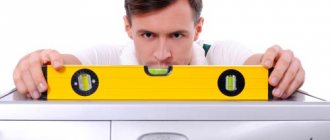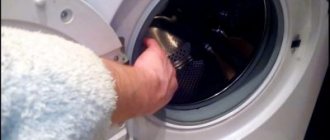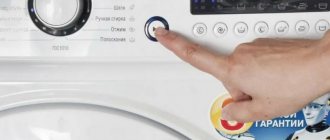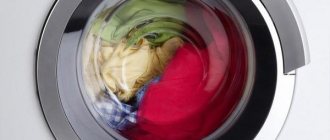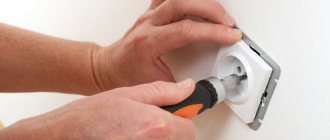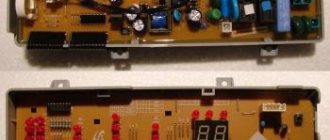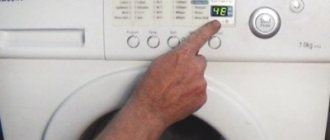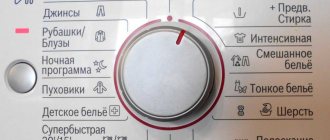Is your washing machine shaking and humming like a rocket about to take off? In this article we will talk about the main causes of noise and vibration during spinning. Let's look at how you can fix problems yourself and when you should still contact a specialist.
The connection manual is universal, suitable for all models with vertical and horizontal loading of the brands Ariston, Bosch, Candy, Gorenje, Indesit, Samsung, Siemens, Zanussi, Ariston, Bosch, Aeg, Beko, Electrolux, Haier and others.
Go!
Failure to comply with operating rules
The most common reason. The round shape of the drum helps to mix wet laundry into one pile. Manufacturers write in all instructions about the need to put small and medium-sized items into the machine along with large and bulky items to create balance. But it’s enough to leave one duvet cover unfastened for them all to become one big heap, which is difficult to turn around. To prevent such situations, you need to put the laundry folded for washing, making sure to fasten all the zippers and buttons.
Overload can also cause the washer to bounce and jump. In this case, stop the machine, drain the water and separate the laundry into parts. Always load laundry evenly, since the service life of the equipment depends on proper use.
Recommendations for choosing a good washing machine
When purchasing a new washing machine, keep in mind that narrow varieties are more susceptible to vibration. The problem is based on a smaller area of support on the surface and a greater height. Stability, accordingly, becomes lower than that of conventional models. In addition, in a narrow drum, things are more likely to clump together, as a result of which the device suddenly begins to jump.
The more weight of laundry a washing machine can support, the less likely it is to vibrate in situations of overload or lack of space for even distribution. The presence of a belt is equivalent to another assistant for damping vibrations. It is also noted that models with a metal drum make more noise during spinning.
Correctly identifying the problem that is causing the machine to jump will help eliminate it. Characteristics of the sound (dull knocking, grinding or noise during operation) and visual inspection of parts will make it possible to carry out correct diagnostics and identify the source of vibrations.
A number of shortcomings and breakdowns can be eliminated on your own, but resolving issues with the operation of the electric motor and bearings requires the intervention of service center specialists.
Technical reasons
In addition to operational reasons, there are many other reasons why a machine knocks and moves (“dances”). Incorrect installation of equipment, failure of important parts and components. It can be difficult to fix such problems on your own. However, if they are diagnosed correctly, it is quite possible.
The floor is uneven or slippery
Uneven position of the legs is one of the common reasons that the machine rattles and bounces. To verify this, simply shake the machine. If it wobbles, determine which direction is more. And on this side, twist the leg, lifting it higher. This problem is common in homes with wood floors. Here you need to spend a lot of time to bring the machine into a perfectly level position.
Slippery floors are another possible cause. The washing machine simply rides on its rubberized legs on wet marble or tiles. Sometimes this happens on laminate flooring too. The solution may be to purchase special pads that will hold firmly even on the most slippery surfaces. Other options: an anti-slip silicone mat or moving it to another location.
Installation not level
If the machine is tilted to one side, the counterweight located inside the body, which holds it during operation, will be directed in that direction. This problem can be identified visually by examining the machine from a distance. If there is a building level, it will show exactly where the machine is tilted. To correct the situation, it is enough to place the equipment correctly.
Shipping bolts not removed
If the new machine hums, trembles and “walks”, the transport bolts may not have been removed. They are located on the back wall and are installed so that the drum remains in place during transportation. As a rule, there are four bolts. Unscrew with a regular screwdriver.
Don't throw them away: when moving, shipping bolts will help keep the mechanical insides of the machine intact.
Shock absorbers and dampers
Shock absorbers are cylinder-like parts with a rod, a piston and a “return” spring. Designed to dampen vibrations that appear at high speeds. Improved shock absorbers with an entire spring system are called “dampers”. Some modern car brands are equipped with them.
The service life of both is quite limited. They can fail if overloaded frequently. You can check the serviceability of the shock absorbers by removing the rear or front part of the car.
To begin with, try simply pressing on the tank. If it immediately snaps into place, then everything is fine with them. Otherwise, the tank will return with a slight delay.
All specified parts are paired. Therefore, if one shock absorber fails, both need to be replaced. Their cost is low, much cheaper than an additional call to a specialist. The same applies to dampers.
It's also worth checking the springs that support the tank. They are located on both sides and can stretch from prolonged use. They can also be replaced in pairs.
The engine runs rough
In addition to the stable and even noise of vibration or knocking, a completely different, sharp sound may occur, usually accompanied by a burning smell. This is a sign of engine failure. This happens due to its long service life, voltage surge or burnout of the armature winding.
If such sounds are produced by a recently purchased car, we are talking about a defective manufacturer. In this case, it is better to contact the service center while the warranty is valid (for washing machines, as a rule, for at least a year).
Objects stuck between drum and tank
Sometimes locks, brooches and other decorations fall out during washing. They fall into the holes of the drum and, periodically catching on it, make creaking sounds. To detect foreign objects, just look under the hatch cuff. If the object fell further, you will have to unscrew the heating element and other elements.
Bearings are worn out
The washing machine makes a characteristic noise and rumbles: the bearings may have failed. Rotate the drum by hand. Inhomogeneous rotation, sometimes quite difficult, indicates that it is time to replace this consumable.
If this is not done in a timely manner, excessive load will appear on the shaft and drum, which will lead to more expensive repairs in the future. Bearings are considered consumable items, requiring replacement every 3-5 years. Fortunately they are inexpensive. If you wish, you can replace them yourself.
The belt has dried out
If the drum spins too easily and produces an unpleasant scraping sound, there may be a problem with the direct drive. The drive belt serves to connect the drum and the engine. Infrequent use of the washing machine or prolonged work on worn out bearings leads to weakening of the tension. How to accurately determine that the problem is in the belt and what to do about it can be read here.
Damaged shaft
In addition to strong vibration and “jumping,” damage to the shaft may be indicated by rusty stains at the bottom of the washing machine. This is a serious breakdown. You won’t be able to fix it yourself without the proper experience.
Fastenings of internal elements are loose
Another reason why the washing machine “walks” and even “dances” on the surface may be insufficient fastening of the internal elements. If this is not corrected in a timely manner, several main components will fail at once. Therefore, you should check how well the crosspiece, counterweight and fasteners supporting the tank are tightened. If necessary, secure more firmly.
Troubleshooting yourself
To eliminate some malfunctions, it is not necessary to take the device to a service center; you can do everything yourself. To do this, you need to do the following:
- If foreign objects get behind the drum, you need to bend the rubber seal of the hatch on the front panel, fixing the drum. After this, you should hook the item and pull it out. If you can’t do this, the only thing that will help is removing the heating element and disassembling the automatic machine, which is best left to a professional.
- If the laundry is unevenly distributed, you need to perform an emergency drain of water and unlock the hatch. Next, you should take out the laundry, separate them from each other and carefully place them in the drum. If overload is observed, then remove some of the things from the machine.
- If there is a problem with installation, you need to determine the correct height using a level and adjust the legs of the washer. You can also level the floor or lay down a sheet of chipboard, fiberboard, or anti-vibration pads. Using a rubberized mat will also help if the device slides on the surface.
- If there are transport bolts, you need to turn the machine with the back wall towards you and unscrew 3 or 4 fasteners with a wrench or pliers. In some cases, there are more fasteners, and they are located under the top cover, so it is better to check the instructions first. In their place are installed the plastic plugs supplied. The removed bolts should not be thrown away; they will be useful when moving or rearranging during repairs.
- If you have problems with the shock absorbers, you need to unscrew them and try to compress them. Since their task is to dampen vibrations, movement should be difficult. If this is easy to do, it means that both structures need to be replaced. If only one is corrected, the stiffness will be different and the load will be distributed unevenly.
- If there are difficulties with the counterweights, you need to remove the machine panel (using pliers, a screwdriver, a wrench) and inspect the counterweights. If they crumble, then buy and install new ones. If it is not available for sale, you can tighten the parts with metal plates or glue them together, although this is a rather complicated option. When the counterweights look intact, it is worth examining their mountings, as well as the springs. If they break, they are replaced, but if they are intact, the bolts are tightened.
- To resolve the issue with the electric motor, you need to remove the back panel and try to tighten the fasteners. Also, removing the far cover will allow you to determine the condition of the belt leading from the engine to the drum. Other actions with the motor and the programmable part of the device cannot be carried out independently.
- Bearing failure can only be repaired by a service center.
Tips and tricks
In most cases, you can remove the vibration of the washing machine during the spin cycle yourself. To do this, it is enough to evaluate how level it is using a level. If you don’t have one, use a bottle half filled with water, on which draw a straight vertical line in the center. After this, place the container on the washer and see how much the water level deviates from the horizon.
To prevent the washing machine from jumping and humming here and now, you can use the following items:
- Place cardboard and thick paper under the legs on the swinging side.
- If the floor is too slippery, use a cotton rag - it will increase resistance and allow you to complete the wash cycle.
- In the future, it is better to buy an anti-vibration and anti-slip mat.
Troubleshooting Tips
The following recommendations will help you solve some problems with your machine, which begins to shake during the spin cycle:
- You should always read the instructions first. It indicates the main technical problems and their manifestations, as well as the location of all structural elements.
- If the washing machine is under warranty after purchase, you should not try to disassemble it yourself. These actions may serve as grounds for refusing further interaction on the issue of breakdown.
- Before performing any manipulations, you need to drain the water, then disconnect the device from the power source.
- Finding out the reason for jumping during push-ups should be done in the direction from simple to complex. First, check the installation of the machine, its sliding, and the distribution of the laundry. Then the presence of foreign things in the tank and transport fastenings on the wall. Only after this they begin to inspect the internal parts.
- When disassembling, it is advisable to mark the elements in the sequence of their removal, sketch a drawing of the location, or take photographs of the process so as not to confuse the parts.
- All complex and dangerous actions should be carried out only by specialists. Fixing the problem will cost more, but the machine will work and the owner’s health will remain intact.
When to worry - additional signs
A malfunction should be suspected only when play in the washing machine drum is accompanied by the following additional symptoms, one or more:
- The washing machine makes a lot of noise, especially during the spin cycle.
- During the spin cycle, the drum knocks on the SMA body or on the glass of the hatch
- The machine jumps or vibrates strongly during the spin cycle
- The belt regularly falls off the pulley
- The drum rubs against the hatch cuff
- The machine seems to wash and spin normally, but it makes noise or creaks when the drum rotates
- Traces of an oily dark liquid are visible under the washing machine
- SM leaks from below, if you remove the back wall, rusty traces of leaks are visible on the tank
- The washing machine stains the laundry with black oil or rust stains
- The washing machine drum flew off and fell to the bottom of the tank
- The drum is jammed and rotates heavily with a metallic grinding noise.
- SMA chews on things
- The washing machine breaks plugs or smokes
- SM drum warped
Attention! A loose drum in combination with any of the listed symptoms indicates a serious malfunction. Even if the machine fully performs all cycles of the program, we do not recommend its operation. This will lead to more serious malfunctions, including the equipment being written off as scrap.
Transport bolts
Transport bolts
First of all, we note that this problem is inherent in new washing machines. Or, when moving, bolts were installed and then forgotten to remove. They are installed at the factory to prevent the tank from knocking on the body and being destroyed. After installation at the site of operation, they must be dismantled, because they interfere with the free movement of the tank.
Quite a common situation. Many citizens believe that there is nothing complicated about installing a washing machine and do it themselves. The bolts are not removed, although this is written in the instructions!
Expert opinion
I work in the household appliance repair industry. Extensive experience in restoring washing machines and dishwashers.
Ask a Question
When installing the SMA yourself, remove the transportation bolts!
Loosening the counterweights
Counterweights are attached directly to the tank of the machine at the top and bottom. There are two types of counterweights used in washing machines:
- Plastic;
- Concrete.
Problems most often arise with concrete counterweights because they crumble over time. Also, due to constant vibration, the fastening bolts may become loose. The counterweights can be accessed by removing the top and front covers of the machine. If the problem is in the bolts, then you just need to tighten them. If the counterweight bursts, then it must be replaced with a similar one. Increased vibration is the main reason for rapid wear of washing machine parts.
Uneven distribution of laundry
The reason for strong vibration may be trivial and lie in the uneven distribution of laundry in the drum. When wet clothes roll up into one large ball, they have considerable weight. The rotation of such a lump can also cause vibration and bouncing of the machine. The solution to the problem is very simple - stop the washing process and lay out each item separately.
Strong vibrations can lead to damage to the drum and tub of the washing machine; if such symptoms are detected, you should immediately contact our specialists.
This video will help you understand the possible causes of vibration more clearly:
Shock absorbers are worn out
Washing machine shock absorbers
It is difficult to predict the lifespan of shock absorbers. It depends on many factors - operating conditions, weight of loaded laundry, number of washes performed. This problem is typical for cars that are not new, older than 5 years. It is possible to impartially determine the need for replacement only when it is removed. We indirectly find out about the presence of wear, in the following way - we pull the tank up and down.
If it drops easily, then most likely the shock absorbers are already damaged and need to be replaced. It is necessary to purchase with a pressure force no less than that indicated in the documentation. Excess is possible, but not more than 20%. Otherwise, this will lead to incorrect operation. And probably the car will also jump and shift, but for a different reason.
You can do the repair yourself if you have the necessary tools and skills. As a rule, to replace it, it is enough to turn the washer on its side.
Expert opinion
I work in the household appliance repair industry. Extensive experience in restoring washing machines and dishwashers.
Ask a Question
Important! When tilting, keep in mind that the control module must always be at the top!
In washing machines of the Indezit, Ariston, Bosch brands, shock absorbers are screwed to the body with screws. In Zanussi and Electrolux, they are fixed with plastic bushings with a latch-type lock, and they cannot be changed without disassembling the case.
